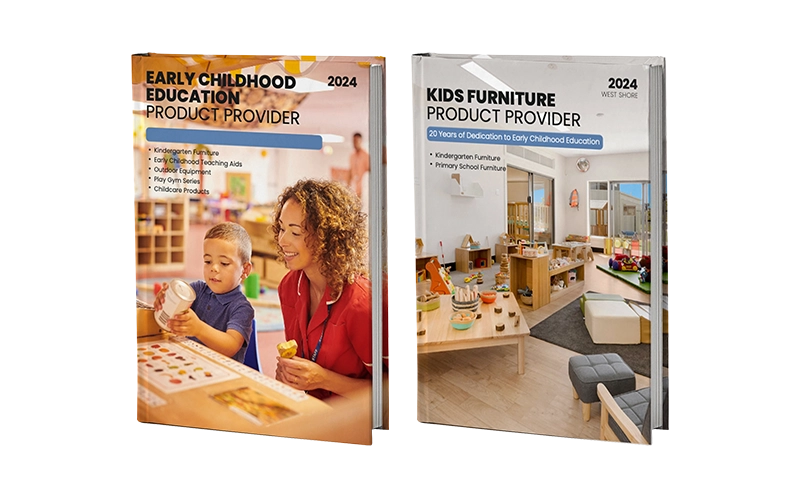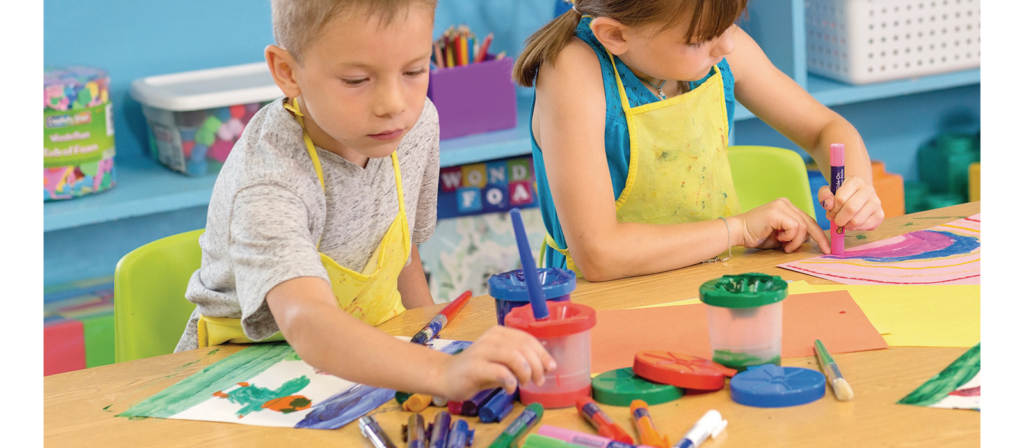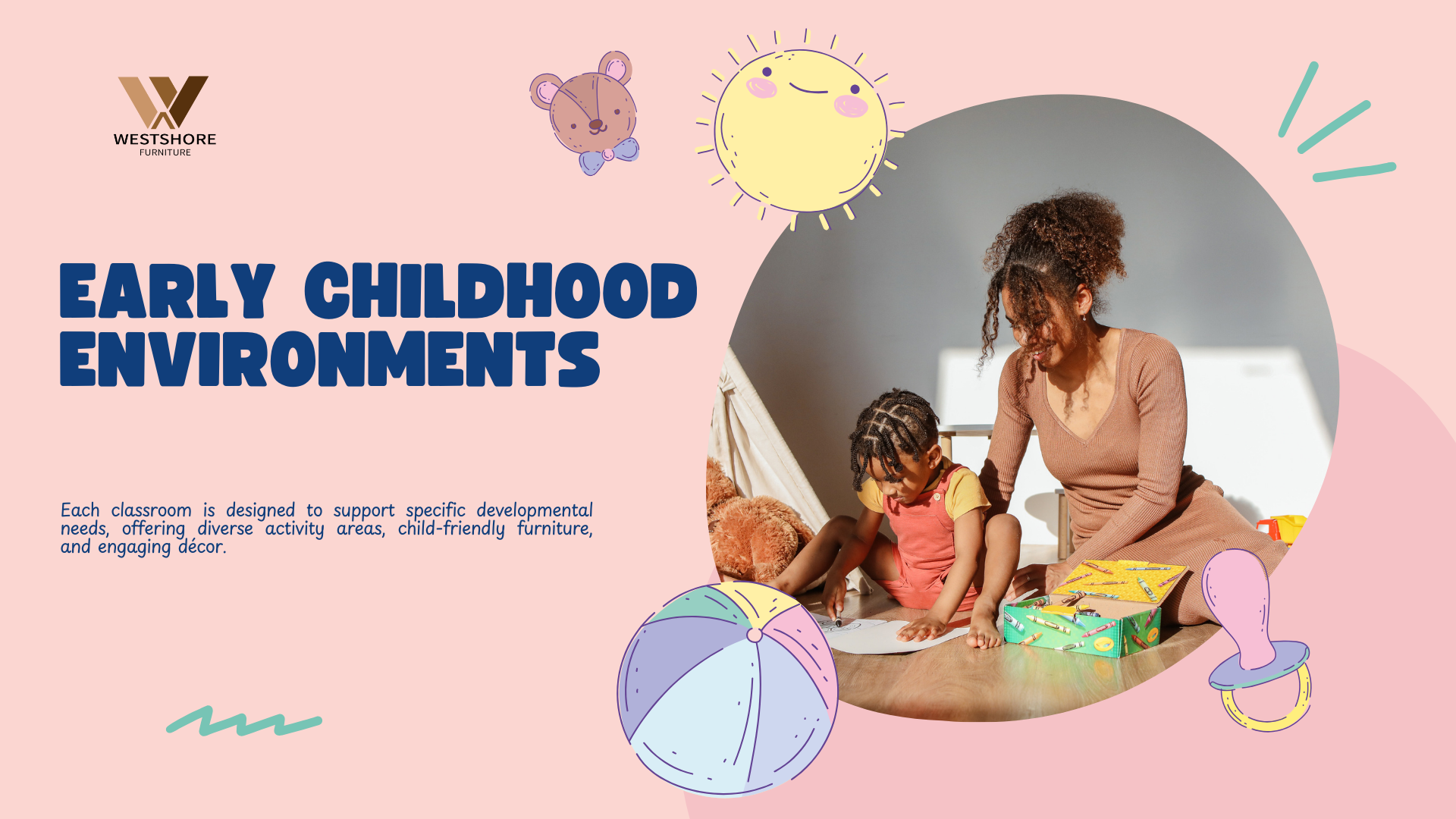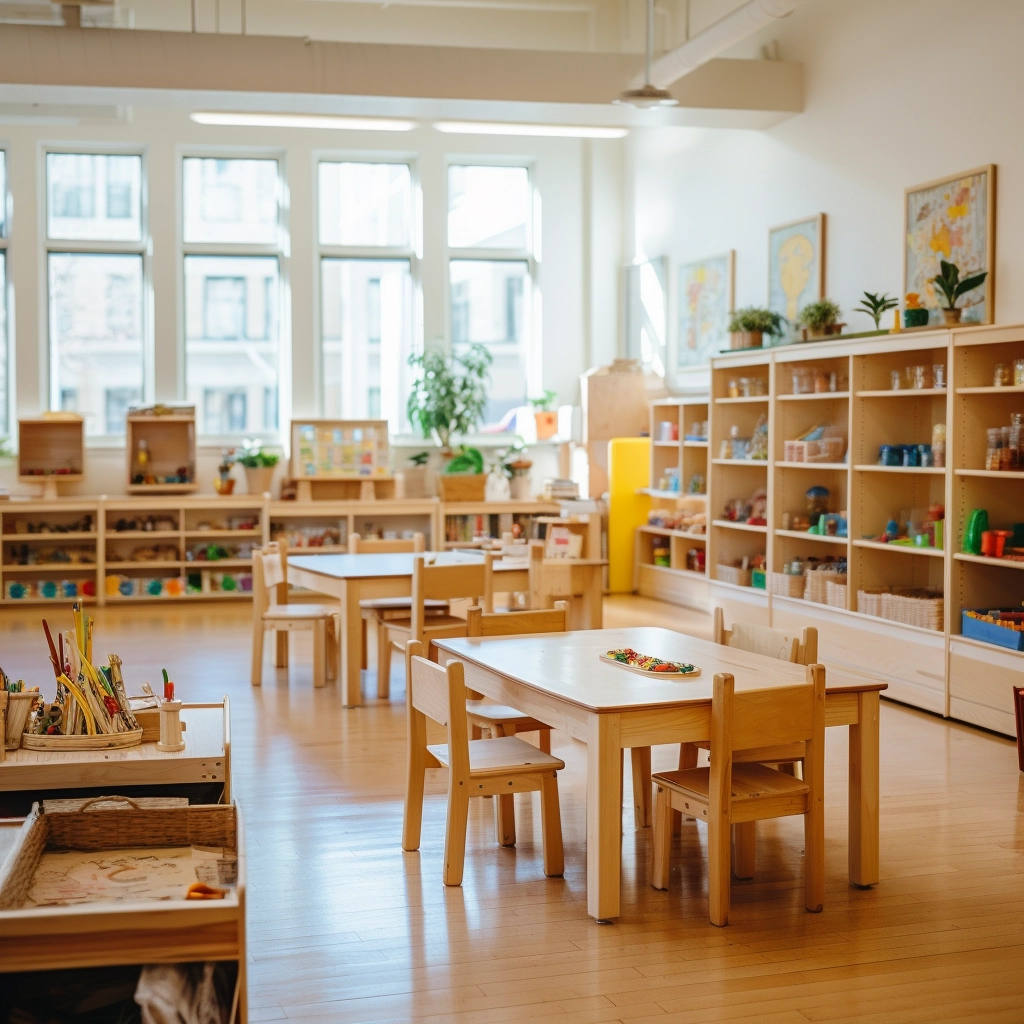Are today’s early childhood environments truly meeting children’s developmental, physical, and emotional needs? Do they offer safety, autonomy, and a sense of emotional security? Too often, we see learning spaces filled with colorful toys and furniture but lacking the structure, purpose, and intentionality that define high-quality early childhood environments. When the environment fails to meet a child’s needs, no amount of curriculum can compensate.
Effective early childhood environments promote child-led discovery, academic development, and emotional security, providing a solid foundation for lifelong learning. But their value goes far beyond surface-level aesthetics or convenience, supporting every aspect of a child’s growth: cognitive, social-emotional, language, physical, and executive functioning. Early childhood environments are not just the backdrop for learning; they are an active, living framework that shapes how children think, feel, behave, and learn for years to come.
Early Childhood Environments shape how children learn and grow. Let’s explore how to design spaces supporting development, autonomy, and joyful learning.

Early Childhood Environments
Early childhood environments are nurturing, intentional spaces that support every aspect of a young child’s development. These environments include more than just classrooms; they also encompass play areas, caregiving zones, and outdoor spaces for exploration. Well-organized and flexible, they offer age-appropriate materials, responsive routines, and rich opportunities for choice, discovery, and learning.
A good environment can bring the following benefits:
-
Support Holistic Development
Early childhood environments nurture children’s cognitive, physical, social, emotional, and language development, creating a strong foundation for lifelong learning. -
Promote Independence and Autonomy
Child-accessible materials and thoughtfully organized spaces empower children to make choices, solve problems, and take responsibility for their learning. -
Enhance Self-Regulation Skills
Predictable routines and well-managed transitions help children develop emotional control, patience, and the ability to manage their behavior. -
Foster a Love for Learning
Engaging, play-based environments stimulate curiosity and creativity, encouraging children to explore, experiment, and discover new ideas. -
Strengthen Social Competence
Children learn communication, empathy, teamwork, and conflict resolution skills through cooperative play and group activities.
Considerations You Need to Consider about Early Childhood
Effective early childhood environments require thoughtful planning. Below are key considerations to guide their design and implementation.
Development and Learning Are Dynamic Processes
Child development is not linear or isolated; it’s a dynamic process shaped by a child’s biological characteristics and environment. High-quality early childhood environments do more than support learning; they interact with the child to influence long-term growth. This ongoing interplay must guide how we design classroom spaces, materials, and experiences.
All Developmental Domains Are Interconnected
In effective early childhood environments, it is essential to support the full range of developmental domains: physical, cognitive, social-emotional, and linguistic, including multilingual learning. These areas are deeply interrelated. For instance, strengthening a child’s language skills often supports emotional expression and cognitive reasoning. The environment should offer rich, multi-domain experiences that reflect this integration.
Play Is Essential for Learning
Play is a cornerstone of early childhood education. Children develop self-regulation, language, problem-solving, and content knowledge through play across disciplines. Play is not optional in well-designed early childhood environments; it is intentionally embedded into daily routines and learning centers. Structured and unstructured play opportunities help children explore, imagine, and connect with the world around them.
Development Is Influenced by Culture and Individual Differences
While there are general patterns in child development, every child’s growth is shaped by unique cultural, social, and personal experiences. Early childhood environments must be flexible and inclusive, allowing children to express their identities, see their cultures reflected, and engage at their own pace. Educators should design environments that are both developmentally appropriate and culturally responsive.
Children Are Active Learners from Birth
Children construct knowledge from birth through interactions with people, materials, and their surroundings. Early childhood environments should be designed to stimulate curiosity, allow hands-on exploration, and encourage meaningful relationships. Learning spaces must reflect the understanding that children are not passive receivers but engaged participants in their learning journeys.
Key Components for Creating Early Childhood Environments
Creating effective early childhood environments involves three key components (Gordon & Browne, 2016):
- Physical environment – the layout, furniture, and materials children interact with.
- Social-emotional environment – the space’s tone, relationships, and emotional safety.
- Temporal environment – the daily schedule, routines, and transitions that structure the day.
These elements shape how children learn, play, and grow within a thoughtfully prepared space.
| Component | Description |
| Physical Environment | How the physical space is designed and laid out, both inside and outside. This includes the learning centers/areas, furniture and equipment, and materials. |
| Social-Emotional Environment | The interactions and relationships between children, teachers, and family members. |
| Temporal Environment | The flow of time, including the timing, sequence, and length of routines and activities throughout the day. |
These three components must be thoughtfully planned and consistently applied to create an environment that genuinely supports the learning and development of infants, toddlers, and preschoolers. Every element of the classroom, including its layout, materials, schedule, and tone, should reflect the program’s educational philosophy and learning goals.
For example, a program focused on early math development may feature more materials related to numeracy, sorting, and pattern recognition. If the program follows a Montessori-inspired approach, the classroom might include tactile tools like bead chains or number rods to help children explore math concepts through hands-on experiences, rather than direct instruction.
The following sections will examine the physical, social-emotional, and temporal components of effective early childhood environments and how they work together to support meaningful, child-centered learning.
Physical Environment in Early Childhood Environments
The physical environment refers to a classroom’s overall design, layout, organization, and learning areas. It is critical in shaping children’s engagement, independence, and developmental growth. A well-prepared physical space goes beyond aesthetics; it supports learning by being functional, inclusive, and developmentally appropriate.
Teachers and program leaders should carefully design the environment by arranging furniture, materials, and activity zones to maximize accessibility and learning opportunities for every child. One practical approach is the Universal Design for Learning (UDL), which emphasizes making spaces and materials accessible to all learners, regardless of ability or background. This could include placing books at varying reading levels, storing materials within easy reach, or creating wide walkways to accommodate children who use mobility aids.
Educators should consider more than furniture size when planning a high-quality physical environment. They must think through traffic flow, visibility, lighting, quiet and active zones, and how each area supports specific learning goals. The ultimate goal is to create a space where children feel confident, competent, and free to explore, an environment that responds to their needs and encourages daily active, meaningful engagement.

Arrangement and Selection of Daycare Furnishings
The arrangement and selection of daycare furnishings are foundational in shaping effective early childhood environments. Furniture is more than just a necessity; it directly influences how children interact with their space, develop independence, and engage in daily activities. Thoughtfully chosen preschool tables, daycare chairs, shelving units, and other classroom furnishings help define learning zones, support developmental goals, and ensure daily safety and comfort.
Key Requirements for Daycare Furniture Arrangement and Selection:
- Child-sized and age-appropriate – Furniture should match children’s size to support independence and comfort.
- Safe and durable – Use sturdy materials with rounded edges and non-toxic finishes.
- Easy to clean – Surfaces must allow for quick, daily sanitation.
- Defined learning zones – Arrange furniture to create clear, purposeful activity areas.
- Smooth traffic flow – Ensure children can move around safely and freely.
- Flexible layout – Choose movable or modular pieces to support changing classroom needs.
Essential daycare furniture for young children’s environments:
A well-equipped early childhood classroom requires safe, functional, and developmentally appropriate furniture. The following are must-have pieces of daycare furniture that support learning, independence, and classroom flow:
- Child-Sized Tables and Chairs
- Open Shelving Units
- Cubby Storage or Lockers
- Activity Center Furniture
- Circle Time Seating (Rugs or Benches)
- Dramatic Play Furniture
- Nap Time Furniture
- Teacher Workstation and Storage
- Snack or Dining Tables
- Mobile Storage Carts
At West Shore Furniture, our preschool furniture is designed for early childhood environments. Every piece is crafted from eco-friendly, certified-safe materials, with child-friendly dimensions and smooth edges that support safety and comfort. As a factory with five production lines, we ensure strict quality control and offer highly competitive wholesale pricing. Whether you’re furnishing a new daycare center or upgrading an existing classroom, our modular shelving, tables, and chairs are built to support real-world educational needs. They are durable, beautiful, and made for learning.

Selection and Placement of Materials
The materials used in a classroom should be intentionally chosen to align with learning goals and developmental stages. Items must be accessible to children, placed on open shelves at eye level and labeled clearly with images or text. Diversity in materials (puzzles, manipulatives, books, natural objects) encourages curiosity and supports multiple domains of development. Rotating materials regularly based on themes or interests helps maintain engagement while preventing overstimulation. Placement should also encourage self-direction, allowing children to select, use, and return items with minimal adult help.
Essential Learning Materials in Early Childhood Environments:
A well-prepared early childhood environment includes various hands-on learning materials that support children’s development across all domains. Below is a list of must-have educational materials for any high-quality early learning setting:
- Sensorial Materials
- Math Materials
- Language Materials
- Science and Nature Materials
- Art Supplies
- Practical Life Tools
- Dramatic Play Props
- Manipulatives and Puzzles
- Music and Movement Materials
- Cultural and Social Awareness Materials
Arrangement of Floor Coverings
Floor coverings in early childhood environments serve more than just aesthetic purposes; they define space, reduce noise, and support comfort and safety. Rugs, mats, or foam tiles can visually separate activity zones, such as quiet reading corners or building areas. Soft surfaces encourage sitting, crawling, or stretching, making them ideal for infants and toddlers. Choose non-slip, washable materials that are both durable and developmentally appropriate. The color and texture of floor coverings also influence mood and focus, so avoid overly bright or busy patterns that may distract young learners in structured learning zones.
- Use rugs or soft mats to define play, reading, or group work areas.
- Select non-slip, easy-to-clean materials for safety and hygiene.
Design and Display of Visual Materials
In effective early childhood environments, visual elements should be purposeful and developmentally aligned. Posters, artwork, and learning charts must be displayed at children’s eye level to reinforce literacy, numeracy, and cultural awareness. Incorporating child-made art fosters ownership and a sense of belonging. Keep displays organized and aligned with current classroom themes or learning units. Avoid clutter, as too many visuals can distract rather than engage. Instead, use display boards or rotating panels to keep the early childhood environment visually stimulating but not overwhelming.
- Hang visuals at children’s eye level to support engagement and recognition.
- Prioritize child-made artwork and culturally responsive images over decorative clutter.
Lighting and Sound
The sensory quality of lighting and sound is essential in shaping the tone of early childhood environments. Natural light enhances mood, alertness, and concentration. Where natural light is limited, use soft, diffused artificial lighting that mimics daylight. Avoid fluorescent bulbs, which can cause eye strain and discomfort. As for sound, classrooms should strike a balance, quiet enough for focus yet dynamic enough for social learning. Soft furnishings, rugs, and acoustic panels help absorb excess noise. Designated quiet zones in the early childhood environment also allow children to self-regulate or decompress when overstimulated.
- Maximize natural light to boost mood and focus.
- Add soft furnishings or acoustic panels to reduce noise and create a calm atmosphere.
Other Tips
Here are additional strategies to optimize the quality of early childhood environments:
- Create a calm, welcoming atmosphere with natural elements like indoor plants, wooden textures, and soft lighting.
- Display family photos, home languages, and cultural items in the environment to include families and foster a sense of belonging.
- Support children with disabilities by ensuring all areas are physically accessible and providing adaptive materials when necessary.
- Keep the space clean and clutter-free through regular sanitization and removal of broken or unused items.
- Rotate materials regularly to maintain engagement and reflect children’s changing interests and learning themes in the early childhood environment.
Social Environment in Early Childhood Environments
A well-prepared social environment is just as important as the physical layout of the classroom. It shapes how children relate to others, express themselves, and develop key social-emotional skills. The social environment in early childhood is built through daily interactions, emotional tone, group dynamics, and the overall classroom culture.
An effective social environment fosters a sense of safety, respect, and belonging. It supports children in developing empathy, cooperation, and communication skills, all essential foundations for later success in school and life. Educators play a central role in modeling positive behavior, guiding interactions, and designing group activities that promote collaboration and mutual respect.
The quality of the social environment is not accidental; it is the result of planning, thoughtful teacher-child interactions, and a clear understanding of child development. Below are three core areas that contribute to a strong social environment.

Group Size and Composition
Smaller groups typically allow for more individualized attention, reduced behavioral issues, and stronger child-teacher relationships. Educators should consider a balance of ages, personalities, and developmental levels when planning group composition. Mixed-age groups, for example, can promote peer learning, while smaller peer groups may support more focused collaboration.
Classroom activities should be flexible enough to accommodate whole-group, small-group, and one-on-one interactions, depending on the developmental goals and needs of the children. Intentionally grouping children to promote positive peer interactions can also help build empathy and social understanding.
Teacher- Versus Child-Initiated Activities
An effective social environment balances teacher-led and child-initiated activities. Teacher-led activities provide structure and intentional instruction, while child-initiated experiences allow children to express themselves, explore freely, and engage with peers on their terms.
When children can choose activities, they are more likely to collaborate, solve problems, and develop leadership skills. On the other hand, guided small-group activities can be used to teach cooperation, turn-taking, and listening skills. This balance fosters autonomy and social accountability, both crucial in early development.
Materials and Activities That Promote Interaction
Materials and activities should encourage meaningful social interactions, not just parallel play. Board games, cooperative building sets, role-play props, and storytelling tools are all examples of resources that promote conversation, negotiation, and collaboration.
Open-ended materials, such as blocks or dramatic play items, invite children to co-create scenarios, assign roles, and communicate ideas, laying the groundwork for more complex social relationships. Educators can further support this by modeling social language, guiding children in resolving conflicts, sharing materials, and working as a team.
Temporal Environment in Early Childhood Environments
The temporal environment refers to how time is structured and experienced in early childhood settings. It includes the daily schedule, the pace of activities, transitions, and how routines are taught and maintained. A well-organized temporal environment helps children feel secure, understand expectations, and build self-regulation skills.
Time in early childhood classrooms should not be rushed or rigid. Instead, it should be predictable yet flexible, allowing children enough time to explore, focus, and transition smoothly. Children who know what to expect are more confident and can engage meaningfully in learning.

Below are three essential strategies for creating a strong temporal environment:
Vary Activity Levels
Balancing active and quiet times throughout the day is essential in effective early childhood environments. Children’s energy levels fluctuate, and a thoughtful schedule should reflect this natural rhythm. Alternate between high-energy activities (like outdoor play or music and movement) and quieter periods (such as story time or table work) to maintain engagement and emotional regulation.
This balance helps prevent overstimulation and encourages self-regulation. For example, a morning might start with an active circle time followed by independent exploration. In the afternoon, a quieter routine may support rest or self-directed learning. By allowing flexibility within each time block, early childhood environments can better respond to children’s individual needs.
Plan Effective Transitions
Transitions are moments of change that, when poorly managed, can disrupt the learning flow. In high-quality early childhood environments, transitions are predictable, smooth, and developmentally appropriate. Teachers should use consistent visual, auditory, or verbal cues to help children shift from one activity to the next.
To minimize stress and maximize continuity, educators can apply simple, effective strategies:
- Provide verbal countdowns (e.g., “Five more minutes, then we clean up.”)
- Use songs, claps, or gestures to signal transitions
- Assign small jobs (e.g., passing out materials) to keep children engaged
With clear expectations and routine reinforcement, children in well-structured early childhood environments become more confident navigating transitions independently. The learning time. Over time, children anticipate what’s next and move more independently between activities.
Teach Routines and Schedules
Clear, predictable routines help children feel secure and capable. From arrival to departure, every part of the day should follow a rhythm that children can learn and follow over time. Visual schedules, daily charts, and consistent routines reduce anxiety and build independence.
Teachers should take time to teach routines explicitly, not just once, but repeatedly, especially in the first few weeks of school or after schedule changes. This includes:
- How to line up
- Where to put materials
- What to do when they finish an activity
With consistent reinforcement, routines become internalized. Children then use less cognitive effort on what to do next and more on learning and social engagement.
Activity Areas and Materials Support Disciplinary and Cross-Disciplinary Learning
In a well-prepared early childhood environment, activity areas or learning centers are designed to promote both disciplinary (subject-specific) and cross-disciplinary learning. These centers allow children to explore core subjects such as math, science, literacy, and the arts through hands-on, inquiry-based experiences.
Each learning center within early childhood environments serves a unique function and connects with others, encouraging children to make conceptual connections across different domains. For example, building a tower in the block center involves math, physics, spatial awareness, and even cooperation, all within a single activity.
Below is a breakdown of the key learning centers commonly found in early childhood environments, and how each supports both individual subject goals and interdisciplinary thinking:
Block Center
The block center is a foundation for developing math, science, and engineering concepts. Children explore measurement, balance, shapes, patterns, and cause-and-effect relationships through building and construction. The center also encourages collaboration and problem-solving, as children negotiate roles and design structures together.

Math/Manipulative Center
This center focuses on number sense, patterns, sorting, sequencing, and fine motor skills. Materials like counting bears, pattern blocks, beads, and puzzles reinforce early math concepts in playful ways. Many of these tools also strengthen logical thinking and hand-eye coordination.

Library Center
The library fosters early literacy, vocabulary development, listening skills, and a love of reading. Its cozy, inviting space, with various fiction and nonfiction books, encourages children to explore stories and information independently or with peers.

Writing Center
Children experiment with mark-making and drawing at the writing center and eventually form letters and words. Materials such as paper, pencils, stencils, name cards, and alphabet charts support early writing and language development. The center is also a space for expressing thoughts and building early composition skills.

Art Center
This is where creativity and emotional expression take center stage. Children use paint, glue, collage items, and clay to explore textures, colors, and design. The art center supports fine motor development and self-expression and often integrates concepts from science, math, and language.

Science Center
The science center nurtures curiosity and inquiry-based learning. Tools like magnifying glasses, natural objects, water tables, and life cycle displays promote observation, prediction, and experimentation. It’s where children learn to ask questions and seek answers through hands-on exploration.

Dramatic Play Center
In this center, children take on roles and act out real-world situations. It’s a hub for social development, language, problem-solving, and cultural understanding. Whether playing family, store, or doctor, children practice cooperation and empathy while engaging in complex symbolic play.

Media Center
The media center introduces children to digital literacy and responsible technology use. Tools like tablets, audio players, or interactive whiteboards support storytelling, listening comprehension, and research in age-appropriate ways. It can also reinforce content from other centers, such as using a math app to practice counting.

Cooking Center
Cooking supports math, science, language, and life skills. Measuring, mixing, following recipes, and discussing ingredients provide rich, cross-disciplinary learning experiences. It also helps children develop responsibility and teamwork.

Meeting Area
The meeting area is the heart of the classroom community. It’s where children come together for group discussions, storytime, music, and morning meetings. This space fosters social-emotional learning, listening, public speaking, and a sense of classroom identity.

Outdoor Area
Outdoor learning promotes gross motor development, nature exploration, and social interaction. Whether through gardening, sand play, or climbing, children build physical skills while exploring scientific and environmental concepts.

Storing Materials to Support Children’s Autonomy
A well-organized storage system within early childhood environments fosters independence, autonomy, and a strong sense of responsibility in young children. When materials are stored in a way that is both accessible and clearly labeled, children are empowered to make choices, initiate activities, and clean up after themselves, building habits that support long-term self-regulation and executive functioning.
To achieve this, shelves in the early childhood environment should be open, low, and within children’s reach, allowing them to see and select the materials they need without adult assistance. Items should have consistent locations, and labels with images and words should be placed on both the containers and the shelves. This guides children where to find and return items, enhancing early literacy development as children begin associating printed words with real objects in their environment.
By giving children control over their learning tools and organization, we shift ownership of the learning process into their hands. At West Shore Furniture, many of our shelving units are designed specifically for this purpose. They are durable, child-height, and compatible with Montessori and Reggio Emilia early childhood environments. Whether managing a preschool classroom or a home-based program, intentional material storage is key to nurturing confident, capable learners.


Looking for durable, affordable, and child-friendly furniture? Please request a quote from us now.

Real Classrooms, Thoughtfully Designed for Early Learning Success
At West Shore Furniture, we manufacture furniture and help schools worldwide build exceptional early childhood environments. Our classrooms are designed to meet the highest safety, functionality, and developmental appropriateness standards.
From open shelving that promotes autonomy to defined learning zones that support disciplinary and cross-disciplinary exploration, every layout is tailored to support how young children learn best, through choice, movement, and hands-on discovery. Whether it is a block center that sparks collaboration or a writing corner that nurtures early literacy, our products help educators create warm, engaging, and ready spaces for learning.
Across North America, Europe, and Australia, our clients are seeing real results: improved student focus, smoother daily routines, and environments children genuinely love to be in. With durable materials, child-sized proportions, and thoughtful design, our classrooms bring early childhood education to life.



View our client cases to see more good early childhood environments!
FAQs: Early Childhood Environments
1. How do early childhood environments support children’s independence?
Well-designed early childhood environments use child-sized furniture, open shelving, and clearly labeled materials to help children make independent choices. These settings empower children to access tools independently, return them properly, and take initiative, building confidence and self-regulation skills from an early age.
2. How can teachers create effective early childhood environments on a budget?
Creating effective early childhood environments doesn’t require expensive materials. Focus on core essentials: modular, child-sized furniture; natural lighting; flexible layouts; and accessible, open-ended learning materials. At West Shore Furniture, we offer affordable, durable classroom solutions tailored for schools seeking high-quality solutions without exceeding their budget.
3. What is the difference between disciplinary and cross-disciplinary learning in early childhood environments?
Disciplinary learning focuses on subject-specific skills, such as math or literacy, while cross-disciplinary learning integrates multiple domains in one activity. In a well-prepared early childhood environment, children naturally engage in both. For example, building a block structure involves math, engineering, and social skills simultaneously.
4. How do early childhood environments support children with disabilities?
Inclusive early childhood environments prioritize Universal Design for Learning (UDL). This means materials are accessible to all children, with adaptive equipment, flexible layouts, and individualized support. These environments ensure every child, regardless of ability, can fully participate, explore, and confidently learn.
5. How often should materials be rotated in early childhood classrooms?
To keep children engaged, materials in early childhood environments should be rotated every 1–2 weeks or as interests shift. Rotation maintains curiosity, prevents overstimulation, and allows teachers to align materials with seasonal themes or specific learning objectives.
6. How can the social and emotional environment be improved in early childhood settings?
Teachers can improve the social environment by building strong relationships, setting consistent expectations, and modeling positive interactions. Creating a warm, inclusive, and respectful early childhood environment helps children feel safe, valued, and ready to learn.





